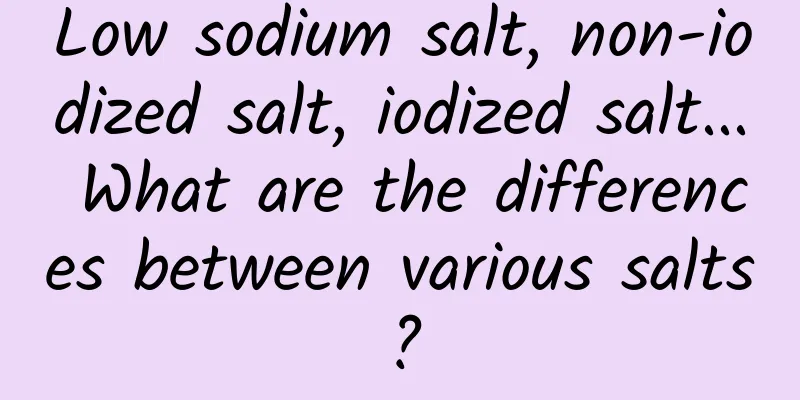Low sodium salt, non-iodized salt, iodized salt... What are the differences between various salts?

|
This article was reviewed by Li Lin, PhD in Food Science, Professor of Zhongshan College, University of Electronic Science and Technology of China, and food safety expert in Zhongshan City As people age, their taste sensitivity decreases, and they need to eat saltier food to taste the flavor. However, if salt intake exceeds the standard, it will lead to excessive sodium intake, which is one of the main dietary risk factors for high blood pressure. In January 2022, Professor Wu Yangfeng from the Peking University Clinical Research Institute published an article in the "Chinese Circulation Journal" stating that promoting low-sodium salt among the population, that is, mixing a certain proportion of potassium chloride, which also has a salty taste, into ordinary table salt (sodium chloride content 90%~99%) to reduce the intake of sodium chloride, has great public health significance. Large-scale studies have confirmed that: An article published in the New England Journal of Medicine in 2021 by Wu Yangfeng's team from Peking University studied the effects of low-sodium salt (replacing sodium chloride with 25% potassium chloride) on cardiovascular events and mortality. The experiment involved 20,995 people in 600 villages in China. The participants were people over 60 years old with a history of stroke or hypertension, with an average follow-up time of 4.74 years. The results showed that for people with a history of stroke or aged 60 years and above with hypertension, the incidence of stroke, major cardiovascular events and all-cause mortality was lower when consuming low-sodium salt than when consuming regular salt. In collaboration with international scholars from Australia, the United States, and the United Kingdom, nearly 21,000 people with a history of stroke or uncontrolled hypertension from 600 villages in 10 counties in five northern provinces of my country were selected. The study provided free low-sodium salt containing 25% potassium chloride to more than 10,000 subjects in 300 villages randomly assigned to the intervention group for five consecutive years. More than 10,000 subjects in another 300 villages randomly assigned to the control group continued to use ordinary table salt. The results showed that compared with the control group using ordinary table salt, the intervention group using low-sodium salt reduced fatal and non-fatal stroke by 14%, major adverse cardiovascular events by 13%, and all-cause mortality by 12%. Low sodium salt, non-iodized salt, iodized salt… In fact, if we classify salt according to its main ingredients, it can be divided into three categories: low-sodium salt, iodized salt, and non-iodized salt. 1. Low sodium salt - not suitable for kidney disease patients We all know that eating too much salt will increase the risk of high blood pressure, but in fact, the real culprit that induces high blood pressure is not salt, but sodium. Yu Luyang, director of the Center for Disease Control and Prevention in Shenhe District, Liaoning Province, pointed out in an article in 2016 that human blood vessels are permeable and sodium is like a sponge. If too much sodium is consumed, it will absorb water and cause water and sodium retention, increase blood volume, and increase pressure on blood vessels. If this continues for a long time, the pressure on blood vessels will increase, leading to high blood pressure. Therefore, low-sodium salt has become the choice of many people. Director Yu Luyang explained that low-sodium salt is a nutritional salt. Compared with ordinary salt, its sodium chloride content is reduced by about 30%. The sodium chloride content of traditional salt is over 95%, while 30% potassium chloride is added to low-sodium salt, reducing the sodium chloride content to about 70%. While almost not affecting the salty taste, it reduces sodium intake and effectively increases potassium intake. Potassium can just play a role in restricting sodium. When the sodium content in food is high, potassium cannot play a regulatory role. However, if potassium intake is increased in food, it can promote the excretion of sodium and reduce the phenomenon of water and sodium retention. Low-sodium salt just plays such a role. Therefore, in your daily diet, you can replace ordinary salt with low-sodium salt. But it should be noted that it does not mean that you can take low-sodium salt at will, and you still need to control the total salt intake according to the standard. In addition, low sodium salt is not suitable for everyone. Qin Jianguo, chief physician of the Department of Nephrology at the Oriental Hospital of Beijing University of Chinese Medicine, pointed out in an interview with reporters in 2017 that low-sodium salt contains more potassium. Kidney patients, especially those with urination dysfunction (such as uremia), should not eat low-sodium salt. Excessive potassium cannot be effectively excreted from the body. Accumulation in the body will cause hyperkalemia, which can easily lead to arrhythmia and the risk of heart failure. 2. Iodized salt - recommended for iodine-deficient areas Most of the salt we consume in our daily lives is iodized salt. The reason why iodine is added to table salt is that my country was once a country with a serious prevalence of iodine deficiency. Since 1996, my country has begun to implement iodized salt for all the people. After the former Ministry of Health revised the "Standards for the Use of Food Nutrient Fortifiers" in 2012, it is no longer allowed to add nutritional fortifiers other than iodine to table salt. The iodine content of table salt can be selected at three levels: 20mg/kg, 25mg/kg, and 30mg/kg. However, there have been various opinions on the Internet about whether it is necessary to continue to consume iodized salt. Some people believe that my country has been supplementing iodine for so many years and there is no need to consume iodized salt; others say that coastal areas eat more seafood and iodine can be supplemented by food; there is also a view that iodine deficiency has serious consequences and iodine supplementation should continue. Ding Xia, deputy chief physician of the Nutrition Department of the Affiliated Hospital of Nantong University, pointed out in an article in 2019 that the iodine content of common foods is: fresh kelp 114μg/100g, dried seaweed 4323μg/100g, dried shrimp 265μg/100g, mussels 346μg/100g, and dried shrimp 82μg/100g. Therefore, if you only use foods with higher iodine content to meet the general adult iodine requirement of 120μg/d, you need to eat 105g of fresh kelp or 3g of dried seaweed or 45g of dried shrimp every day. According to China's "Iodine Content of Edible Salt" standard, if the iodine level of salt fortification is 25mg/kg, 5g of salt is consumed per day, and the cooking loss is calculated as 20%, 100μg of iodine can be ingested from iodized salt every day, plus iodine in drinking water and food, it can meet the iodine requirement of the general population. Therefore, if you live in a coastal city and consume a lot of seafood, you don’t need to choose iodized salt. However, if you don’t consume enough seafood or live in an iodine-deficient area, it is recommended to use iodized salt. 3. Non-iodized salt - not recommended for two types of people But iodized salt is not suitable for everyone. In 2017, Song Xiangyang, director of the Department of Thyroid and Breast Surgery at Zhejiang Provincial People's Hospital, pointed out in an interview with the media that there are two types of people who are not suitable for consuming iodized salt: The first category is patients with thyroid diseases such as hyperthyroidism, thyroiditis, and autoimmune thyroid disease. Due to treatment needs, they can follow the doctor's advice and not eat or eat less iodized salt. The other group is residents living in high-iodine areas or non-iodine-deficient areas. They already get sufficient doses of iodine from food and drinking water every day. This group of people should not consume iodized salt either. Source: Health Times This article has been authorized. Please contact the original author for reprinting. The pictures in this article with the "Science Popularization China" watermark are all from the copyright gallery. The pictures are not authorized for reprinting. |
<<: Hu Q&A丨The more foam a laundry detergent produces, the stronger its cleaning ability?
>>: Will toothpaste develop "drug resistance"? Do you need to change it frequently?
Recommend
It has been prevalent recently, so be extra careful!
Recently, the high temperature and high humidity ...
Cross-border B brother-tiktok advertising quick start course
A comprehensive explanation of the practical oper...
Goddess crash course: How to build your attractiveness? 12 series of lessons to teach you step by step
A beautiful appearance but a boring soul can only...
Douyin Box Product Experience Report
The product inspection report of Douyin Box has j...
AutoNavi Product Manager: Good voice navigation is definitely not just for Lin Chiling and Guo Degang
Recently, AutoNavi Map released a funny version, ...
Advertising case in wedding photography industry!
During the epidemic, the wedding photography indu...
The perfect protein comparable to animal protein is actually eaten frequently
Many fitness people who dream of having eight-pac...
Refined operations: How to establish a user tag system?
With the disappearance of traffic dividends, the ...
Using HOOK to achieve response speed test in seconds
Author: Jin Jianchao, Yang Chen, Unit: China Mobi...
[PP Assistant Special Self-Recommendation Issue 1] Don’t miss the opportunity to bring volume to Android for free!
PP Assistant seeks comprehensive benefits for dev...
Yogurt, vinegar, honey water, do these hangover remedies really work? | Science Gallery
The Spring Festival is the most important traditi...
Zhang Shanling's Three Major Axes at Alibaba (21 Lectures) [Completed]
Zhang Shanling's 21 Lectures on Alibaba's...
Talk: "Zhejiang" scientist - Su Buqing: The "geometry" of his life depicts his original aspirations
...
How does Anker run its Facebook advertising page?
Anker is a big player in the Amazon industry. Eve...
RWDS Illustration Course, First Edition, From Beginner to Metamorphosis [High Definition with Materials]
RWDS Illustration Course, First Edition, From Beg...









